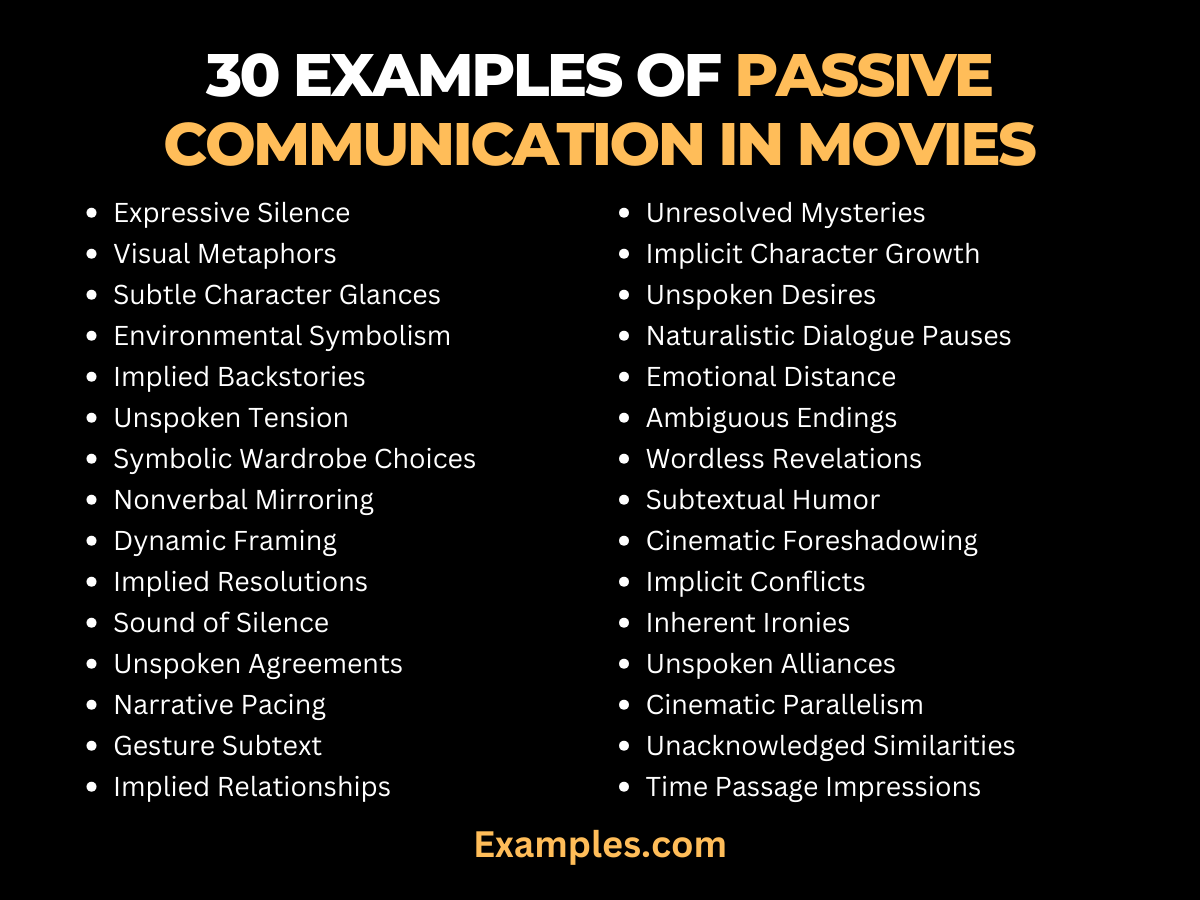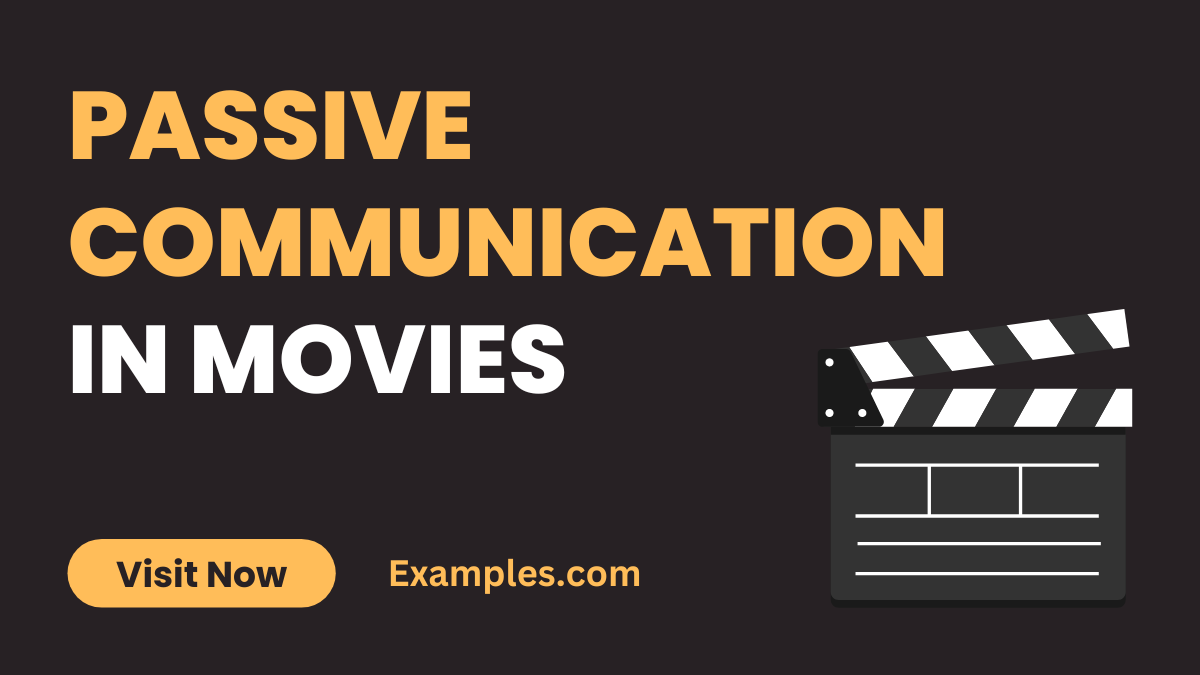Passive Communication in Movies
Immerse yourself in the enchanting world of passive communication within the realm of cinema. This complete guide explores the significance and impact of passive communication in movies, unravelling the art of conveying emotions, relationships, and narratives without explicit dialogue. Uncover the nuances with vivid Communication Examples, showcasing how filmmakers ingeniously weave unspoken cues into the visual tapestry of storytelling. Embark on a journey to appreciate the subtle language that speaks volumes on the silver screen.
30 Examples of Passive Communication in Movies
Unlock the cinematic treasures of Passive Communication in movies, redefining storytelling dynamics. Dive into a world where subtle gestures and unspoken nuances contribute to a rich narrative tapestry. Explore the benefits of this nuanced communication style, enhancing the viewer’s experience and deepening emotional connections with characters and plots.

- Expressive Silence: In pivotal moments, characters convey profound emotions through wordless pauses, letting the audience interpret the intensity.
- Visual Metaphors: Filmmakers use symbolic imagery to convey complex ideas, offering viewers a visual language to decipher underlying themes.
- Subtle Character Glances: A character’s fleeting glance can communicate volumes, revealing hidden feelings or intentions without explicit dialogue.
- Environmental Symbolism: Utilizing settings and surroundings to mirror characters’ emotions adds depth to the narrative, enhancing the viewer’s immersion.
- Implied Backstories: Filmmakers craft rich, unspoken histories for characters, allowing audiences to infer and engage with the plot on a deeper level.
- Unspoken Tension: Silence between characters in a scene can create palpable tension, heightening the emotional stakes of a story.
- Symbolic Wardrobe Choices: Costume design becomes a silent storyteller, conveying character traits, journeys, and transformations without spoken words.
- Nonverbal Mirroring: Characters mirroring each other’s body language subtly signify connection, empathy, or shared experiences.
- Dynamic Framing: Filmmakers use framing techniques to emphasize unspoken power dynamics, subtly guiding the viewer’s interpretation.
- Implied Resolutions: Not every conflict needs explicit resolution; filmmakers often leave space for viewers to imagine outcomes, enhancing engagement.
- Sound of Silence: Strategic use of silence in sound design punctuates moments, inviting the audience to absorb the gravity of a scene without words.
- Unspoken Agreements: Characters may reach mutual understandings without verbal contracts, relying on shared glances or nods.
- Narrative Pacing: The deliberate slowing or speeding of storytelling cues guides emotional responses without overt verbal cues.
- Gesture Subtext: Simple gestures carry layers of meaning, offering insight into characters’ personalities, motivations, or relationships.
- Implied Relationships: Not all relationships need explicit exposition; filmmakers use subtle cues to hint at connections, leaving room for interpretation.
- Unresolved Mysteries: Some stories deliberately leave aspects unexplained, allowing viewers to ponder and engage beyond the closing credits.
- Implicit Character Growth: Changes in a character’s demeanour or expressions subtly signal personal growth or transformation.
- Unspoken Desires: Characters’ unexpressed wants or dreams add depth, letting viewers infer motivations and aspirations.
- Naturalistic Dialogue Pauses: Mimicking real-life conversations, filmmakers embrace pauses, enabling viewers to absorb and reflect on dialogues.
- Emotional Distance: Characters may maintain a silent emotional distance, fostering intrigue and inviting viewers to decode underlying tensions.
- Ambiguous Endings: Not all stories conclude with a bow; ambiguity invites audience interpretation, sparking post-viewing discussions.
- Wordless Revelations: Critical plot points can unfold without spoken exposition, relying on visuals and actions for impactful revelations.
- Sub textual Humour: Filmmakers infuse subtle humour through actions, expressions, or situations, letting viewers discover comedic layers independently.
- Cinematic Foreshadowing: Visual cues foreshadowing future events invite viewers to predict story arcs, deepening engagement.
- Implicit Conflicts: Characters may navigate conflicts without explicit confrontation, emphasizing emotional subtleties.
- Inherent Ironies: Filmmakers employ irony through visual storytelling, letting viewers discern contrasts and contradictions organically.
- Unspoken Alliances: Characters may form alliances without overt agreements, relying on shared understanding and trust.
- Cinematic Parallelism: Parallel visuals convey thematic connections, offering viewers a visual puzzle to piece together.
- Unacknowledged Similarities: Characters with unspoken similarities invite viewers to draw connections, fostering empathy and understanding.
- Time Passage Impressions: Filmmakers use visuals to signify the passage of time, allowing viewers to absorb temporal shifts without explicit cues.
Importance of Passive Communication in Movies
Unlock the cinematic magic by understanding the significance of passive communication in movies. Explore how subtle gestures, nuanced expressions, and unspoken dialogues contribute to storytelling, creating a profound impact on the viewer’s experience. Dive into the importance of decoding the nonverbal language that breathes life into characters and narratives, elevating cinema beyond spoken words.
- Eloquent Character Development: Passive cues reveal character traits organically, fostering deeper connections without explicit exposition.
- Emotional Resonance: Silent moments evoke emotions, leaving a lasting impact that transcends verbal expression.
- Atmospheric Storytelling: Nonverbal elements shape the film’s atmosphere, immersing audiences in the narrative’s emotional landscape.
- Symbolic Cinematography: Visual metaphors communicate themes and motifs, enriching the viewer’s interpretation.
- Unspoken Conflict Resolution: Characters navigate conflicts through gestures and expressions, allowing resolutions without verbal confrontation.
- Cinematic Subtext: Hidden layers of meaning enrich plots, providing attentive viewers with a tapestry of sub textual narratives.
- Audience Engagement: Decoding nonverbal cues engages viewers actively, inviting them to become part of the storytelling process.
- Visual Harmony: Passive communication creates visual harmony, ensuring a seamless connection between characters and their surroundings.
- Timeless Storytelling: Silent storytelling transcends language barriers, making films universally relatable and timeless.
- Narrative Suspense: Strategic use of passive communication builds suspense, keeping audiences captivated between dialogues.
What is the Role of Passive Communication in Movies
Delve into the multifaceted roles of passive communication in movies, where every unspoken nuance plays a crucial part in shaping characters, plotlines, and the overall cinematic experience. Explore how filmmakers strategically employ nonverbal elements to achieve storytelling excellence.
- Character Depth Enhancement: Silent interactions unveil hidden facets, creating multifaceted characters that resonate with audiences.
- Plot Pacing: Well-timed nonverbal cues guide the pace of the narrative, enhancing the overall storytelling rhythm.
- Visual Story Arcs: Passive communication contributes to character arcs visually, portraying personal growth and transformation.
- Subtle Foreshadowing: Visual hints provide subtle clues about future events, inviting viewers to anticipate plot twists organically.
- Ambient World-Building: Passive elements contribute to building immersive cinematic worlds, enriching the storytelling environment.
- Genre-specific Techniques: Different genres employ unique passive communication methods, from subtle horror cues to heart-warming romance gestures.
- Psychological Impact: Silent moments leave a psychological imprint, allowing audiences to reflect and connect with characters on a deeper level.
- Cultural Representation: Nonverbal cues offer insight into cultural contexts, fostering a nuanced portrayal of diverse backgrounds.
- Visual Harmony with Sound: Passive communication aligns seamlessly with sound design, creating a holistic sensory experience for viewers.
- Visual Storytelling Mastery: Filmmakers utilize passive communication as a storytelling tool, showcasing mastery in the art of visual narrative construction.
In the realm of cinematic storytelling, passive communication serves as a powerful narrative tool, weaving unspoken nuances into the fabric of every scene. This guide has explored diverse examples, from expressive silence to visual metaphors, offering a comprehensive understanding of how subtlety enhances storytelling. Embrace the art of passive communication in movies for a more nuanced and captivating cinematic experience.



